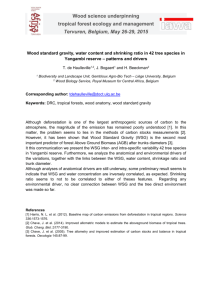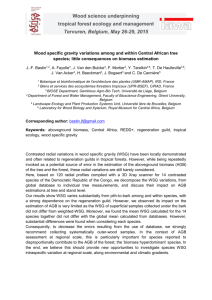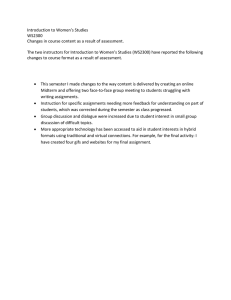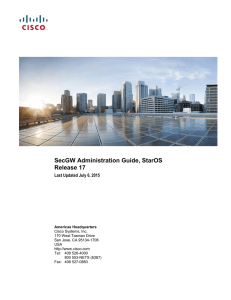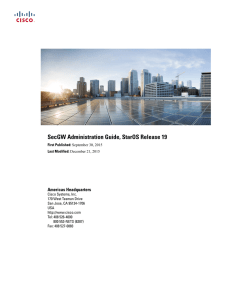ISM 116 – Web Design and Development Spring 2014 Syllabus
advertisement
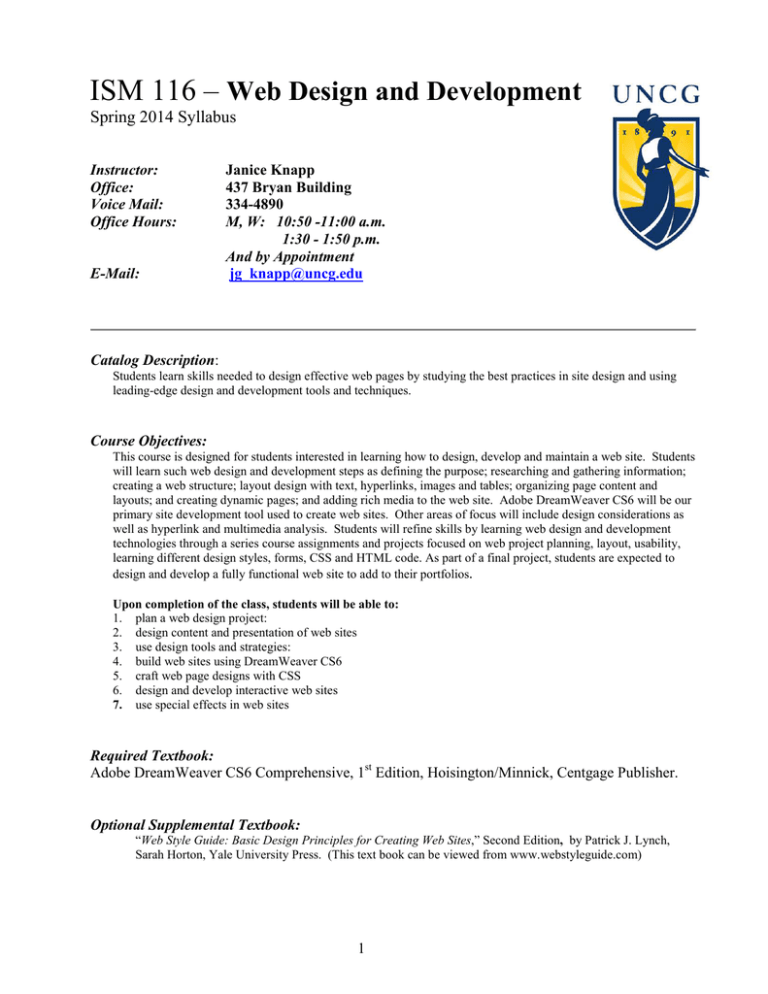
ISM 116 – Web Design and Development Spring 2014 Syllabus Instructor: Office: Voice Mail: Office Hours: E-Mail: Janice Knapp 437 Bryan Building 334-4890 M, W: 10:50 -11:00 a.m. 1:30 - 1:50 p.m. And by Appointment jg_knapp@uncg.edu Catalog Description: Students learn skills needed to design effective web pages by studying the best practices in site design and using leading-edge design and development tools and techniques. Course Objectives: This course is designed for students interested in learning how to design, develop and maintain a web site. Students will learn such web design and development steps as defining the purpose; researching and gathering information; creating a web structure; layout design with text, hyperlinks, images and tables; organizing page content and layouts; and creating dynamic pages; and adding rich media to the web site. Adobe DreamWeaver CS6 will be our primary site development tool used to create web sites. Other areas of focus will include design considerations as well as hyperlink and multimedia analysis. Students will refine skills by learning web design and development technologies through a series course assignments and projects focused on web project planning, layout, usability, learning different design styles, forms, CSS and HTML code. As part of a final project, students are expected to design and develop a fully functional web site to add to their portfolios. Upon completion of the class, students will be able to: 1. plan a web design project: 2. design content and presentation of web sites 3. use design tools and strategies: 4. build web sites using DreamWeaver CS6 5. craft web page designs with CSS 6. design and develop interactive web sites 7. use special effects in web sites Required Textbook: Adobe DreamWeaver CS6 Comprehensive, 1st Edition, Hoisington/Minnick, Centgage Publisher. Optional Supplemental Textbook: “Web Style Guide: Basic Design Principles for Creating Web Sites,” Second Edition, by Patrick J. Lynch, Sarah Horton, Yale University Press. (This text book can be viewed from www.webstyleguide.com) 1 Mid Term and Final Exams: We will have a midterm and a final exam. Each exam is administered in two parts. One part is written and the other part hands-on. Final Project: You will work on a final Web site design and development project for this course. This project is based on a real life case that requires the students to plan, design and develop a fully functional web site. Students are will be required to upload their web site at the end of the semester. More details about the final project and the specifics of the presentation will be given during the course. Projects and Projects: This course is what is called a project intensive course. It means that assignments projects constitute a major portion of the requirements for this course. You are required to complete a number of assignments that I will provide you. More details will be forthcoming during the course of the semester. Each assignment or project is due on the scheduled due date. Please do not procrastinate on the assignments. The practice of meeting commitments is a fundamental obligation with meaningful consequences in a real work setting. There are no extra credit assignments. Instructional Methods: This course will be delivered in on-line format and hands-on computer exercises. To enhance learning both elementary and advanced web design issues, techniques and concepts covered in this course, we will rely on the textbooks, lectures notes, hands-on exercises. Homework assignments and class projects challenge the student to apply the knowledge learned in class. Relationship to other ISOM courses: It is the philosophy of the ISOM department to help students develop an appropriate background and critical skills needed to function effectively in a global, technology-driven environment. Knowledge of web site design and development concepts are an integral part of achieving this goal. To succeed in this course, students must utilize the problem solving and critical reasoning skills that they have acquired as part of their education here at UNCG. The course, in turn, provides web site design and implementation skills as well as other problem solving skills that students can use to succeed in their future academic and professional careers. Attendance Policy: Each student is responsible for all the information and announcements that are made in class. Poor attendance causes poor performance in this course. Because this is a course in the School of Business, students are expected to conduct themselves professionally. A professional shows up for scheduled meetings prepared and on time. A professional does not sleep during a meeting. A professional does not leave prior to the end of the meeting unless there is an extreme emergency. Appropriate class conduct is appropriate professional behavior. Inappropriate class conduct may lower a student's grade. Any student missing the first class without notifying the instructor will be administratively dropped from the course. Any student missing more than three classes (excused or not) may have their grade dropped by a letter grade. Oral and Written Communication Content: Information Systems involves a dynamic environment with constant attention to changes. Active study and discussions enhance learning. Students are encouraged and expected to participate in on-line discussions with one another, through Black Boards’ discussion area. Effective written communication is stressed through the required assignments. Ethical Perspectives: The ultimate goal of a database project is to be able to more effectively manage information in decision-making. The importance of ethical decisions will be addressed in many of the topics covered throughout the course. 2 Global Perspectives: Globalization is a primary objective of the Bryan Business School. However, the discussion of globalization is beyond the scope of this course. Technology Applications: Technological advances in databases may be addressed in the course. Demographic Diversity Perspectives: This course will not specifically address the issue of demographic diversity. Political, Social, Legal, Regulatory, and Environmental Perspectives: The political, social, legal and regulatory issues surrounding the ownership and use of data, and the users’ rights as they pertain to the database environment will be discussed Ethical Issues and the Honor Code Policies: University students are expected to conduct themselves in accordance with the highest standards of academic honesty. Academic misconduct for which a student is subject to penalty includes all forms of cheating, such illicit possession of examinations or examination materials, forgery, or plagiarism. Students will NOT make, borrow, or "share" copies of their lab assignments or files with other students. Plagiarism is defined as "presenting as one’s own work that work which is, in whole or in part, the work of another person or persons without giving proper credit to the appropriate source." This includes submitting work done by another, as one’s own work. It is understood that what you turn in to me for grade represents your own effort. Plagiarism will be immediately punished with a grade of zero for the assignment in question. Further disciplinary action will be pursued as I deem appropriate. Helping one another is allowed, but copying is cheating. This practice is against the UNCG Honor Code and defeats the purpose of this course. No credit will be received for shared work, and other penalties may be imposed. Inclement Weather: Rarely, UNCG closes for inclement weather. The radio and TV stations will have the closing notification by 6:30 am. You may also call 334-5000 for a message related to weather closings. These messages are updated hourly. Grading: Grades for the course are based on tests and lab assignments. The course grade will be calculated using the following weights: Deliverable Points Assignments, Quizzes and Other Projects 400 points Midterm Exam 200 points Final Exam 200 points Final Project 200 points Total Points 1000 points 3 The final grade is determined using the following scale: The grade scale is based upon percent of points earned and is as follows: > 98 = A+ 93-97%=A 90-92%=A87-89%=B+ 83-86%=B 80-82%=B77-79%=C+ 73-76%=C 70-72%=C67-69%=D+ 63-66%=D 60-62%=DBelow 60=F * This syllabus is subject to change upon request of the instructor * 4 Tentative Course Outline ** DW: refers to “Adobe Dreamweaver CS6,” text book. **WSG: refers to “Web Style Guide: Basic Design Principles for Creating Web Sites.” (Optional, recommended) *** Assignments must be submitted before midnight on the Friday of the week they are due Week Topic Readings and Deliverables Week 1 1/13 Introduction Dream Weaver CS6 Understanding the Internet and web site issues Developing a Web Site Plan and Design DW: Introduction: Web Site Development and Adobe CS6 WSG: Chapter 1: Process Chapter 2: Universal Usability Chapter 3: Information Architecture Week 2 1/20 Introduction to Dream Weaver Environment Examine Dream Weaver’s Screen Components. Discuss creating a local site definition, folders and file organization. DW: Chapter 1: Creating a New Web Site with Dream Weaver WSG: Chapter 4: Interface Design Chapter 5: Site Structure Assignment #1 Due Week 3 1/27 Introduction to Cascading Style Sheets and using Templates DW: Chapter 2: Designing a Web Site Using Templates and CSS WSG: Chapter 6: Page Structure Week 4 2/3 Cascading Style Sheets DW: Chapter 2: continued creating CSS styles WSG: Chapter 7: Page Design Assignment #2 Due Week 5 2/10 Inserting Graphics and links DW: Chapter 3: Adding Graphics and Links WSG: Chapter 11: Graphics Week 6 2/17 Working with Tables and Forms DW: Chapter 4: Exploring Tables and forms WSG: Chapter 10: Forms and Applications Assignment #3 due One page or less proposal for final project due Week 7 2/24 Interactive Web pages and Widgets DW: Chapter 4: continued WSG: Chapter 8: Typography Week 8 3/3 Midterm exams Written midterm: March 3 Lab midterm: March 5 March 7: Last Day to drop class Week 9 SPRING BREAK SPRING BREAK (MARCH 8 - 16) Week 10 3/10 Interactive Web Pages DW: Chapter 5 Creating Interactive Web Pages with Spry and Adobe Widgets WSG: Chapter 9: Editorial Style Assignment #4 due Week 11 3/17 Adding Rich Media DW: Chapter 6 Enhancing Web Pages with Audio and Video WSG: Chapter 5: Typography WSG: Chapter 6: Editorial Style 5 Week 12 3/24 Media Objects and Behaviors Week 13 3/31 Creating your Web space to upload your Web site Week 14 4/7 Adding Database Functionality DW: Chapter 7 Media Objects, Behaviors and CSS3 Styling WSG: Chapter 12: Multimedia Work on your final Web Site Projects Assignment #5 due DW: Chapter 8 Publishing a Web Site Work on your final Web Site Projects Adding Database Functionality WSG: Chapter 7: Graphics Assignment #6 due Work on your final Web Site Projects Final Web Site Presentations Work on your final Web Site Projects Upload Final Web Site Projects Final Web Site Presentations Week 15 4/14 Week 16 4/21 Week 17 4/28 Final Exam Part 1 * This is a tentative course outline and deviations from this outline may become necessary. This outline is subject to change upon the request of the instructor * 6
